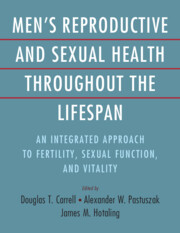 Men's Reproductive and Sexual Health Throughout the Lifespan
Men's Reproductive and Sexual Health Throughout the Lifespan Book contents
- Men’s Reproductive and Sexual Health throughout the Lifespan
- Men’s Reproductive and Sexual Health throughout the Lifespan
- Copyright page
- Contents
- Contributors
- Preface
- Section 1 An Introduction to Men’s Health Care
- Section 2 The Biology of Male Reproduction and Infertility
- Section 3 Clinical Evaluation and Treatment of Male Infertility
- Section 4 Laboratory Evaluation and Treatment of Male Infertility
- Chapter 20 The Modern Semen Analysis
- Chapter 21 The Future of Computer-Assisted Semen Analysis in the Evaluation of Male Infertility
- Chapter 22 Reactive Oxygen Species and Sperm DNA Damage
- Chapter 23 Clinical Value of Sperm DNA Fragmentation Tests
- Chapter 24 The Current Use of Sperm Function Assays
- Chapter 25 Sperm Selection in the Laboratory
- Chapter 26 Methods to Select Ejaculated, Epididymal, and Testicular Spermatozoa for Assisted Conception
- Chapter 27 Optimal Sperm Selection in the ICSI Era
- Chapter 28 Microfluidics for Sperm Sample Preparation and Sperm Identification
- Chapter 29 Practical Concerns for Patient Semen Banking
- Chapter 30 The Potential Future Applications of In Vitro Spermatogenesis in the Clinical Laboratory
- Chapter 31 Spermatogonial Stem Cell Culture and the Future of Germline Gene Editing
- Section 5 Medical and Surgical Management of Issues of Male Health
- Index
- References
Chapter 20 - The Modern Semen Analysis
Theory and Techniques of Ejaculate Examination
from Section 4 - Laboratory Evaluation and Treatment of Male Infertility
Published online by Cambridge University Press: 06 December 2023
- Men’s Reproductive and Sexual Health throughout the Lifespan
- Men’s Reproductive and Sexual Health throughout the Lifespan
- Copyright page
- Contents
- Contributors
- Preface
- Section 1 An Introduction to Men’s Health Care
- Section 2 The Biology of Male Reproduction and Infertility
- Section 3 Clinical Evaluation and Treatment of Male Infertility
- Section 4 Laboratory Evaluation and Treatment of Male Infertility
- Chapter 20 The Modern Semen Analysis
- Chapter 21 The Future of Computer-Assisted Semen Analysis in the Evaluation of Male Infertility
- Chapter 22 Reactive Oxygen Species and Sperm DNA Damage
- Chapter 23 Clinical Value of Sperm DNA Fragmentation Tests
- Chapter 24 The Current Use of Sperm Function Assays
- Chapter 25 Sperm Selection in the Laboratory
- Chapter 26 Methods to Select Ejaculated, Epididymal, and Testicular Spermatozoa for Assisted Conception
- Chapter 27 Optimal Sperm Selection in the ICSI Era
- Chapter 28 Microfluidics for Sperm Sample Preparation and Sperm Identification
- Chapter 29 Practical Concerns for Patient Semen Banking
- Chapter 30 The Potential Future Applications of In Vitro Spermatogenesis in the Clinical Laboratory
- Chapter 31 Spermatogonial Stem Cell Culture and the Future of Germline Gene Editing
- Section 5 Medical and Surgical Management of Issues of Male Health
- Index
- References
Summary
The examination of the human ejaculate constitutes a complicated branch of medical laboratory science. To understand the complexity of the human ejaculate knowledge about the physiology and pathology is facilitating. It is also essential to understand that the main value of ejaculate examination is the information that can be obtained on the functional capacity of the male reproductive organs. Still, the main focus has for a long time only been on the prognostic value for the outcome of the fertility of the couple. In this chapter the focus is on how the functional capacity of the male reproductive trace can reflect in the ejaculate examined in the laboratory. Important principles for reliable laboratory techniques for ejaculate volume, sperm concentration and sperm count, sperm motility, sperm vitality, and sperm morphology are described with requirements for reliability, assessment of uncertainties, need for staff training, internal quality control, and interlaboratory comparisons (external quality control).
- Type
- Chapter
- Information
- Men's Reproductive and Sexual Health Throughout the LifespanAn Integrated Approach to Fertility, Sexual Function, and Vitality, pp. 159 - 164Publisher: Cambridge University PressPrint publication year: 2023
